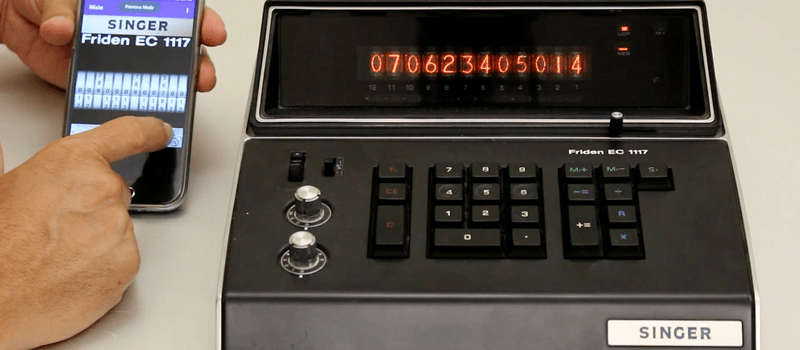In this beautiful and well-documented reverse engineering feat of strength, [Eric Cohen] reverse-engineered a 1971 Singer calculator to gain control of the fabulous Nixie tubes inside. Where a lesser hacker would have simply pulled the tubes out and put them in a more modern housing, [Eric] kept it all intact.
Not even content to gut the box and toss some modern brains inside, he snooped out the calculator’s internal wiring, interfaced a Raspberry Pi to it, and overrode the calculator’s (860 Hz) bus system. With the Pi on the inside, controlling the Nixie tubes, he did what any of us would do: set up a UDP server and write an Android app for his phone to push ASCII data over to the former calculator. When it’s not running in its default clock mode, naturally.
All of this is extraordinarily well documented both on his website, in a slide presentation (PDF), and in video (embedded below). Our hats are tipped to the amazing attention to detail and fantastic documentation.
Now where is that Singer EC1117 calculator from 1971 that we’ve been saving for just such an occasion?


















Not sure what model my Nixie calculator is, but it looks different (and it is white). This seems like a cool use for it, but it would probably need its own custom reversing too. Not sure what is wrong with my 19-inch rack panel nixie frequency counter — last time I dug it out it did not work anymore — probably a capacitor gone bad. This hack adds another yet project to my “to do” list now…
OK, here’s a question, can he use his calculator as a (wait for it) calculator? What I mean is can he push the date from his phones app into the nixie tubes? You know, sort of a ghostulator.
I meant his phones calculator app.
That’s brilliant, and ridiculous, all at the same time. Using a calculator as a calculator! Absurd!
Easier than putting nixie tubes into a smart phone! (Now that would be a hack!)
That’s a good idea. But the next feature is going to be pass through from the native calculator engine to the display, with screen mirroring to the Android rendered in virtual nixie tubes. That’s how I’ll raise my billion dollar series-A round!
Did the “UnDeFined” light inspire Mr. Cohen to use UDP?
I once (in the mid-to-late 70s) used that very same model of calculator to iteratively derive the square root of 2 to 11 decimal places.
As cool as it is, these Nixie tube calculators are getting harder to find, especially working ones. Fair enough if its had a hard life and that was that but this appears to be in pretty nice condition. These early digital devices need to be saved so we can remember where we came form, not just about where we’re heading.
I certainly see your point which is why I tried to be minimally invasive with this and also intend to build a pass through mode. Also I have a couple of these calculators. This one was the first I converted and it actually has the keyboard unit from the base I started with which was a lot more busted up. But overall yeah it’s in pretty good condition and I had a bit of a knot in my stomach when I cut those traces.
Built to last – nothing is built like that now.
The keyboard read switches will last forever. Relaxed wiring looms. Solid connectors and look at those electrolytic capacitors working after so much time – a testament to quality thermal design.
That was before the days of planned obsolescence coming into vogue.